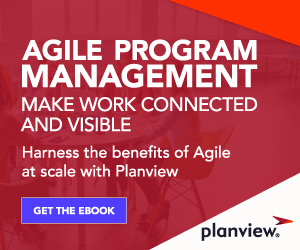
Agile people leaders know how to build relationships, empower teams and individuals, and keep work aligned with company goals.
They understand that a supported and aligned team is one of the most powerful assets a company can have — and they will work hard to set up their teams for success. In many ways, the Agile people leader is the ultimate servant leader.
Servant leadership plays a huge role in building and empowering high-performing teams — as well as teams of teams — in an Agile environment.
Along with servant leadership, there are specific responsibilities that successful Agile people leaders fulfil on behalf of their teams and the organization.
In this post, you’ll learn what makes an Agile people leader unique in their responsibilities, plus six skills that will help you excel in your Agile management role.
You’ll also learn the key capabilities you’ll need from a technology solution to help you connect strategy to delivery, ensure teams are delivering their most impactful work, and enable pivot vs. persevere decisions.

What does an Agile People Leader do?
The adoption of Agile often requires a shift in culture and mindset throughout an organization. It’s a new way of working that affects the people, processes, and technology utilized to deliver value for the business.
Of all the shifts that companies make when they “go Agile,” the change in how they define an effective leader is perhaps the biggest shift of all.
As an Agile people leader, you are a servant leader – someone who mentors the growth and development of your direct reports, while helping all the Agile teams within your purview connect their work to the strategy and the desired business outcomes of the organization.
Your responsibilities include, but aren’t limited to:
- Steering progress of teams
- Managing expertise and capacity
- Managing expectations with all stakeholders
- Lean budgeting for teams
- Strategy and portfolio planning
With so many hats to wear, being an Agile people leader isn’t easy. At the same time as you’re navigating immense organizational change, you’re also leading teams that are experiencing significant change and looking to you for answers.
If you start to feel overwhelmed, remember this:
Being the change agent for an Agile transformation rarely comes without challenges – and always comes with opportunities for exceptional growth.
To take full advantage of this opportunity, it’s important to understand how to be successful in your role as an Agile people leader.
6 Essential Responsibilities of Agile People Leaders
Now that we’ve talked about the role of an Agile people leader, let’s unpack your top responsibilities, as well as the key technology capabilities that you’ll need to scale Agile at your organization.
1. Keep work aligned with strategy
Teams need to understand your company’s business strategy. This will help them adapt to industry and business changes easier, so they can keep the work delivered aligned with company goals and objectives.
Maintaining this alignment requires the kind of end-to-end visibility you get from Kanban. Look for a solution that offers…
- Portfolio boards
- Program boards
- Team boards
When connected, these three boards make it easy for teams and executive leadership to see how the work that’s being done at the team level aligns with the overall company strategy.
This makes it easier for teams and executive leadership to see whether work delivered stays aligned with company strategy. It also provides the necessary level of detail for each audience at the team, program, and portfolio levels to enable pivot vs. persevere decisions.

2. Balance workload with capacity
An Agile people leader must be able to deliver on their commitments. But before they can do this, they need to know:
- The workload of their teams
- Whether teams can take on new work
A program-level Kanban board gives you real-time visibility into the flow of work across a team of teams. It shows you the work plan of teams and the progress of their work, which you can use to determine capacity on an individual team level.
That way, you can confidently make commitments to customers and stakeholders — while enabling the delivery of greater and greater value — without the fear of bogging down teams and setting unrealistic expectations.
3. Address roadblocks and risks
Two of the biggest elements of servant leadership as an Agile people leader are removing roadblocks for your team and addressing risks at the teams-of-teams level.
Dependency conflicts, resource constraints, and other unforeseen challenges can disrupt productivity and affect morale. Once you’re able to identify these risks, you can prevent them from turning into setbacks.
Look for a technology solution that lets you generate exception reports. This will help you:
- Identify problems
- Learn when to intervene
In your day-to-day activities, actively listen for indicators of risk during meetings. Regularly ask your team if anything is preventing them from doing their work and how you can help resolve those issues.
4. Collect data to inform decisions
Whether it’s during team planning meetings or quarterly / PI planning sessions, one question will come up a lot: Do we continue doing the work we’ve been doing? To answer that question objectively, you need to have performance measures in place for the team’s work.
Using metrics to evaluate things helps you:
- Understand team strengths and weaknesses
- Make better decisions regarding capacity
- Facilitate continuous improvement, improve performance, and more
Choose a technology solution that lets you see important program-level delivery metrics like the flow of work, cycle time, and even work that was delayed. This data will help you better understand your team’s performance and capacity. And once you understand that, you can start planning more accurately.
5. Communicate insights to executives
Real-time analytics and consistent reporting help with long-term planning. With the help of Business Intelligence tools, you can generate custom reports that give you better insight into:
- Capacity allocation
- Quality
- Velocity
- Trends over time
Choosing an Agile solution that lets you leverage Business Intelligence tools to provide consistent reporting in a familiar format for executive leadership will go a long way in helping them make truly informed decisions around prioritization, funding, and so much more.
6. Lead continuous improvement
For people leaders, continuous improvement is important on multiple levels. You always need to be on the lookout for ways to improve, whether it’s by facilitating exercises to make your processes more efficient or identify the root cause of a persistent problem, such as delivery delays.
An technology solution that enables you to measure performance over time through in-depth reporting (including flow and speed reports) will help guide improvements to the ways in which work is carried out. This will help you and your teams deliver value more efficiently and effectively.
Bringing it all Together
Being a successful Agile people leader may start with servant leadership, but it doesn’t end there. To lead an Agile team effectively – and to be an influential voice guiding teams-of-teams – you need to focus on the responsibilities that will bring the most value.
Check out our on-demand webinar on people leaders to learn more.
And don’t forget to watch our Agile Program Management solution demo to see how Planview can support your efforts in scaling Agile.




